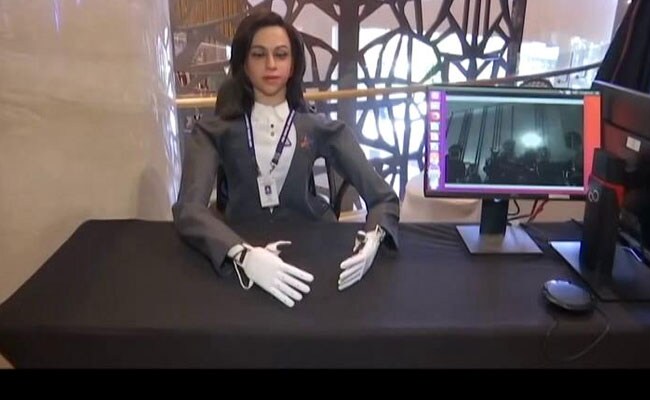Relevance: Mains: G.S paper III: Science and technology
About
Vyommitra, a “half-humanoid” being developed by the Indian Space Research Organisation (ISRO), announced herself in Bengaluru. She is the prototype for a half-humanoid that will eventually fly to space on an unmanned mission later this year, aiming to lay the ground for ISRO’s manned mission Gaganyaan in 2022.
What is a half-humanoid?
A humanoid is basically a robot with the appearance of a human being. ISRO’s Vyommitra (vyoma = space, mitra = friend) is also being called a half-humanoid since she will only have a head, two hands and a torso, and will not have lower limbs.
Like any robot, a humanoid’s functions are determined by the computer systems to which it is connected. With the growth of artificial intelligence and robotics, humanoids are being increasingly used for repetitive jobs, such as that of a waiter at a restaurant. The artificial intelligence technologies that power modern systems such as autonomous cars, or voice-operated systems such as Alexa, Siri, Google Assistant, Cortana and Bixby, are extended in a humanoid to perform simple functions that include walking, moving things, communicating and obeying commands.
Why is ISRO developing a humanoid?
ISRO plans to send a human into space for the first time by 2022. It is racing against time to develop a crew module and rocket systems that will ensure the safe travel and return of the Indian astronaut. Other countries that have successfully launched humans into space did so after having used animals for conducting tests of their rockets and crew recovery systems, while ISRO will use the humanoid to test the efficacy of its GSLV Mk III rocket to transport a human to space and back. The humanoid is under development at a robotics laboratory at the Vikram Sarabhai Space Centre.
ISRO’s GSLV Mk III rocket is currently undergoing improvisation to ensure that it is human-rated or, in other words, declared safe to transport a human being to space. Its first unmanned mission with the human-rated rocket is planned for December 2020. The crew module system, too, is under development, and ISRO will attempt to carry out several tests over the next few months to launch and recover the module using new test launch rockets, which too are under development.
ISRO has considerable experience in building robotic systems for its space projects. Artificial intelligence was at the core of the Vikram lander system used for the September 2019 Chandrayaan 2 mission to the Moon by assessing distances, speeds and processing commands stored in the lander systems (the lander made a failed attempt to descend to the surface from an orbit around the Moon).
Once flown into space, ISRO’s half-humanoid will be able to test systems in the crew module meant for the survival and safe travel of the first Indian astronaut in 2022.
What are the tasks that Vyommitra will perform in space?
A central character in the science-fiction film Interstellar (2014), which is about space and time travel, is an artificial-intelligence -and-robotics-powered computer system called TARS, which talks to the astronauts, assists them in mission functions, and even rescues them in times of crisis. TARS was not a humanoid, but a robotic system with exceptional capabilities.
The Vyommitra humanoid, which will test the ground for the human spaceflight, will be a very basic version of a TARS-type, artificial-intelligence-and-robotics system. The activities that Vyommitra will be able to perform, once fully developed for the unmanned flight, will include procedures to use equipment on board the spacecraft’s crew module such as safety mechanisms and switches, as well as receiving and acting on commands sent from ground stations. Attaining launch and orbital postures, responding to the environment, generating warnings, replacing carbon dioxide canisters, operating switches, monitoring of the crew module, receiving voice commands, responding via speech (bilingual) are the functions listed for the humanoid.
Vyommitra, whose human-like face has already been on display, will have lip movement synchronised to mimic speech. She can also double up as an artificial buddy to an astronaut — providing audio inputs on aspects like the health of the spacecraft during the launch, landing and orbital phases of the manned mission.
Vyommitra will also report back to Earth on the changes occurring in the crew module during the spaceflight and return, such as heat radiation levels, to enable ISRO to understand the safety levels required in the crew module that will eventually fly a human being.
Have other space missions used humanoids?
There have been many space missions featuring dummy astronauts. There have also been many featuring humanoid robots like Vyommitra. The most recent mission with a dummy astronaut was in March 2019, when a mannequin called Ripley was flown on the Dragon crew capsule, launched on a SpaceX Falcon rocket, and sent to the International Space Station. Ripley was fitted with sensors to measure forces that act during a space flight as part of SpaceX preparations to send a human into space in 2020 for NASA.
An artificial intelligence robot ball called CIMON (Crew Interactive Mobile Companion) was deployed on the ISS by Airbus. Int-ball, a floating camera robot, was deployed on the ISS by JAXA space agency.
Kirobo, a humanoid robot astronaut built in Japan, was flown to the ISS along with the first Japanese commander of the ISS, Koichi Wakata, to serve as the astronaut’s assistant in conducting experiments on the space station. Kirobo was equipped with technologies such as speech recognition, facial recognition, language processing and telecommunication capabilities.
A Russian humanoid robot, Fedor, was sent to the ISS in 2019 to carry out mechanical functions on the space station.


